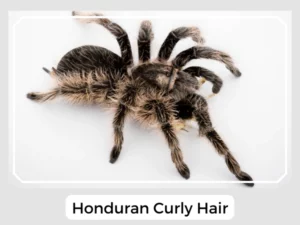The curly hair tarantula is a special kind of tarantula spider. It comes from a place called Costa Rica. What’s cool about this spider? It has a curly look, just like curly hair!
The female lays between 300 and 500 eggs as big as a golf ball that is incubated for 7 to 8 weeks at 24-27°C.
The juvenile spiders are pale in color and develop at a rapid pace, going on to live on their own in a few weeks after hatching.
These spiders can spin silk which is used for lining their burrows and protecting the eggs that are laid there. However, unlike other spiders, they do not make webs by using silk.
Yes, Curly Hair Tarantulas have venom. They use it mainly to catch the bugs they eat. But for people, it’s not very strong.
They can bite if they’re bothered. It might feel like a little pinch, but most people don’t find it too bothersome.
The Curly Hair Tarantula plays a crucial role in maintaining the ecological balance in its habitat. As a predator, it helps control the population of small vertebrates and larger insects, contributing to a healthier environment. Their burrowing behavior also aids in soil aeration, further showcasing their importance in their ecosystem.
Natural Predator: Despite their size and venomous capabilities, Curly Hair Tarantulas are not without predators. They face threats from various birds, reptiles, and even other spider species.
Prey-Predator Dynamics: The Curly Hair Tarantula is a vital component of the food web in its habitat. It preys on smaller creatures, helping regulate their populations, while also serving as prey for larger animals.
Relationship with Humans: Historically, Curly Hair Tarantulas were targeted for international trade, leading to significant captures in the wild. Today, they are more commonly bred in captivity, showcasing their adaptability to varying temperatures and humidity levels. Their listing on CITES ensures that any international trade of this species is regulated, requiring proper permits to prevent overexploitation.
| Other names | Honduran Curly Hair |
| Lifespan in the wild | Males: 4 years; Females: 8 to 10 years |
| Distribution | Rain forests of Nicaragua, Honduras, and Costa Rica |
| Habitat | Tropical scrublands, near large trees and rivers, and in places where the rain forests have been cleared |
| Predators | Several birds, reptiles as well as other spiders |
| Diet | Small vertebrates and larger insects like crickets |
In summary, the Curly Hair Tarantula stands as a testament to the incredible diversity and adaptability of tarantulas worldwide.

The curly hair tarantula is a special kind of tarantula spider. It comes from a place called Costa Rica. What’s cool about this spider? It has a curly look, just like curly hair!
The female lays between 300 and 500 eggs as big as a golf ball that is incubated for 7 to 8 weeks at 24-27°C.
The juvenile spiders are pale in color and develop at a rapid pace, going on to live on their own in a few weeks after hatching.
These spiders can spin silk which is used for lining their burrows and protecting the eggs that are laid there. However, unlike other spiders, they do not make webs by using silk.
Yes, Curly Hair Tarantulas have venom. They use it mainly to catch the bugs they eat. But for people, it’s not very strong.
They can bite if they’re bothered. It might feel like a little pinch, but most people don’t find it too bothersome.
The Curly Hair Tarantula plays a crucial role in maintaining the ecological balance in its habitat. As a predator, it helps control the population of small vertebrates and larger insects, contributing to a healthier environment. Their burrowing behavior also aids in soil aeration, further showcasing their importance in their ecosystem.
Natural Predator: Despite their size and venomous capabilities, Curly Hair Tarantulas are not without predators. They face threats from various birds, reptiles, and even other spider species.
Prey-Predator Dynamics: The Curly Hair Tarantula is a vital component of the food web in its habitat. It preys on smaller creatures, helping regulate their populations, while also serving as prey for larger animals.
Relationship with Humans: Historically, Curly Hair Tarantulas were targeted for international trade, leading to significant captures in the wild. Today, they are more commonly bred in captivity, showcasing their adaptability to varying temperatures and humidity levels. Their listing on CITES ensures that any international trade of this species is regulated, requiring proper permits to prevent overexploitation.
| Other names | Honduran Curly Hair |
| Lifespan in the wild | Males: 4 years; Females: 8 to 10 years |
| Distribution | Rain forests of Nicaragua, Honduras, and Costa Rica |
| Habitat | Tropical scrublands, near large trees and rivers, and in places where the rain forests have been cleared |
| Predators | Several birds, reptiles as well as other spiders |
| Diet | Small vertebrates and larger insects like crickets |
In summary, the Curly Hair Tarantula stands as a testament to the incredible diversity and adaptability of tarantulas worldwide.
